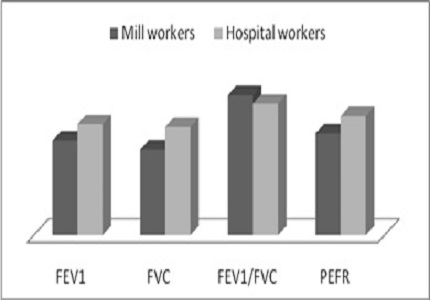Comparative study of Ventilatory Functions of Cotton Mill Workers, Mumbai, India
Abstract
Background & objectives: The present observational study was carried out in cotton mill workers of Mumbai to compare the pulmonary functions with those of apparently healthy population and to find out the effect of duration of exposure to the working environment.
Materials & Methods: The study group comprised of 150 cotton mill workers and 150 workers of hospital staff, all males, in age group of 25-60 years. Socio-demographic characteristics and occupational history was noted in predesigned questionnaire performa for both groups. Respiratory functions namely FEV1, FVC, FEV1/FVC & PEFR were recorded by using portable and electronic instrument pneumotachometer, results were analysed by using difference of means.
Results: The pulmonary functions were found to be significantly lower in cotton mill workers as compared to hospital staff and pulmonary functions were correlated negatively with duration of exposure to the cotton dust.
Conclusion: In spite of modernization and recent technical evolution the working conditions and occupational environment has still a long way to go as per as the safety of cotton mill workers of Mumbai city is concerned.
Downloads
References
M. N. Gupta. Review of byssinosis in India, Ind. J. Med. Res. Sept 1969: 9, 57.
Cotes J. E. Lung Functions, third edition, Oxford blackwell scientific publishers. 1975, page 2-4, 24-30, 99-108.
Proceedings of fifth Asian conference of occupational health. Nov. 17-20, 1968, Bombay, page 102-12.
Douglas K. H. Lee. Environmental factors in respiratory disease. Academic press New York and London, 1972, page 253-57.
American thoracic society guidelines for lung function testing. Selection of reference values and interpretative strategies. Am. Rev. Resp. Dis. 1991; 144, 1201-18.doi: https://doi.org/10.1164/ajrccm/144.5.1202.
Miller MR, Hankinson J, Brusasco V, Burgos F, et al. Standardization of spirometry . Eur Respir J. 2005 Aug;26(2):319-38.doi: https://doi.org/10.1183/09031936.05.00034805 .
Jain SK, Ramaiah T J. Normal standards of pulmonary function tests of healthy Indian men of 15 to 40 years age comparison of different regression equations (predicted formulae). Ind. J. Med. Res. 1969; 57.
Kamat SR, Sarma BS, Raju VR, Venkataraman C et al. Indian norms for pulmonary functions, observed values, prediction equations and inter correlation. Jr Asso Phys Ind 1977 Aug ; 25(8):531-40.
Udwadia FE, Sunawala VM, Shetye VM. Lung function studies in healthy subjects. Jr Asso Phys Ind 1987 36(7):491-96.
Kamat SR, Kamat GR, Salpekar VY, Lobo E. Distinguishing Byssinosis from COPD. Am. Rev. Resp. Dis. July 1981; 124: 31-40.doi: https://doi.org/10.1164/arrd.1981.124.1.31.
Schilling RSF. Byssinosis in cotton and other textile workers, Lancet 1956 Aug ;18(2), 261-64,391-25. doi: https://doi.org/10.1016/s0140-6736(56)92187-0.
Hinson AV, Schlunssen V, Agodokpessi G, Siqsqaards T, Fayomi B. The prevalence of byssinosis among cotton mill workers in the north of Benin. Int J Occup Environ Med. 2014 Oct;5(4):194-200.
Murlidhar V, Murlidhar VJ, Kanhere V. Byssinosis in Bombay textile mill. Natl Med J India 1995 Sep-Oct; 8(5):204-7.
J.V. Jannet, G. P. Jayanthi. Pulmonary health status of ginning factory women labourers in Tirupur, India. Indian Journal of Occupational and Environmental medicine December 2006; Vol 10 (3): 116-120.doi: http://www.ijoem.com/text.asp?2006/10/3/116/29571.
Farooque MI, Khan B, Aziz E, Moosa M, Raheel M, Kumar S, Mansuri FA. Byssinosis: as seen in cotton spinning mill workers of Karachi. J Pak Med Assoc 2008 Feb; 58(2): 95-98.
Krishna MT, Salvi SS. What is the association between air pollution and allergic diseases? JAPI. 2002; 50: 221-225.
Sangeeta Vyas. A study of pulmonary function tests in workers of different dust industries. International journal of basic and applied medical sciences 2012 May-Aug;Vol.2 (2) 15-21. Available on: hhtp://www.cibtech.org/jms.htm
Tiwari RR, Pathak MC and Zodpey SP. Respiratory morbidities in cotton textile workers. Lung India 1999; XVII (1): 23-25.
Mansouri F, Pili JP, Abbasi A, Soltani M, Izadi N. Respiratory problems among cotton mill workers. Lung india 2016; Mar-Apr;33(2):163-66.doi: http://www.lungindia.com/text.asp?2016/33/2/163/177444.
Hasan Kaharaman, Mustafa Haki Sucakli, Talat Kilic, Mustafa Celik, nurahan Koksal and Hasan Cetin Ekerbicer. Longitudinal pulmonary functional loss in cotton textile workers: A 5-year follow-up study. Med Sci Monit. 2013; 19: 1176-1182.doi: https://dx.doi.org/10.12659%2FMSM.889681.
Sunita Kalasuramath, Malay Kumar, Surendra Mannan K, D V Deshpande, Vinodkumar C S. Incidance of byssinosis, effects of indoor pollutants and associated risk factors on lung functions among women working in cotton mills. Int J Basic and Appl Physiol 2015; 4(1): 152-60.http://www.ijbap.com/upload/ijbap-2015/28-ijbap-2015.pdf.
Roger K. Larson, Martin L. Barman. Longitudinal study of pulmonary function in cotton Gin workers in the San Joaquin Valley. Chest October 1989; Vol 96 (4): 819-823.doi: https://doi.org/10.1378/chest.79.4_supplement.22s.



 OAI - Open Archives Initiative
OAI - Open Archives Initiative


